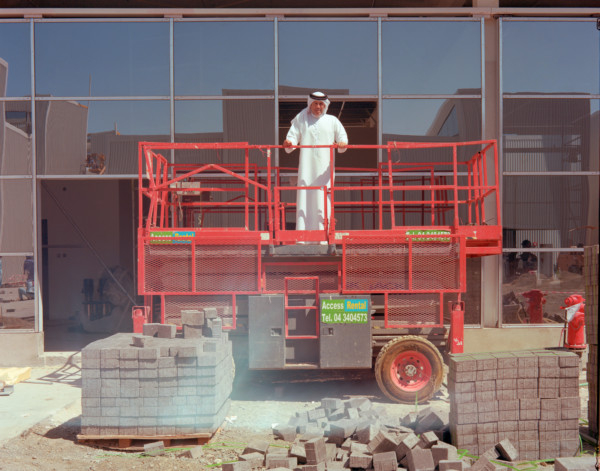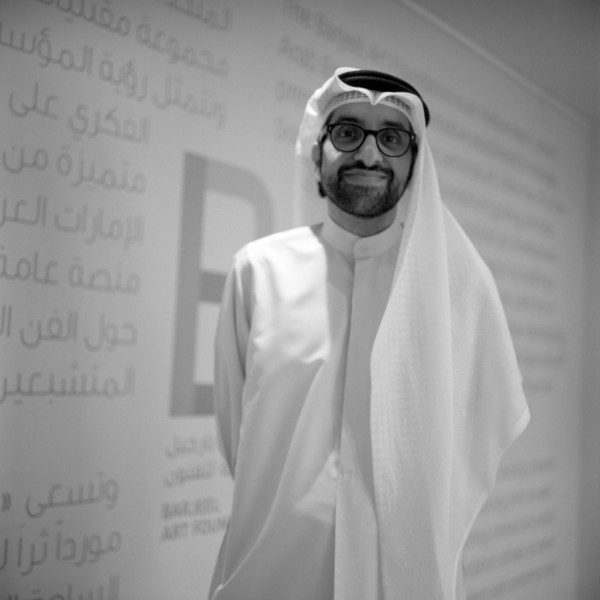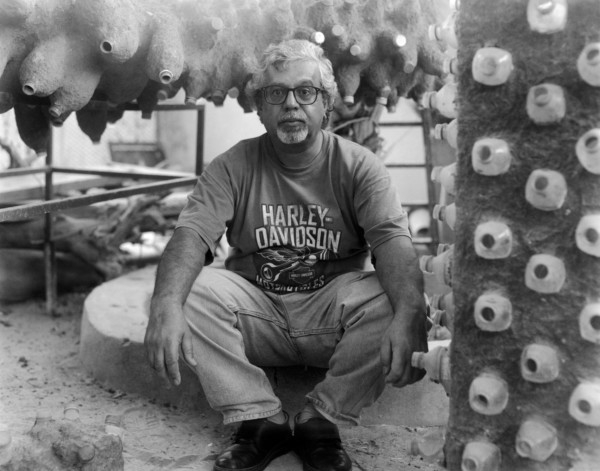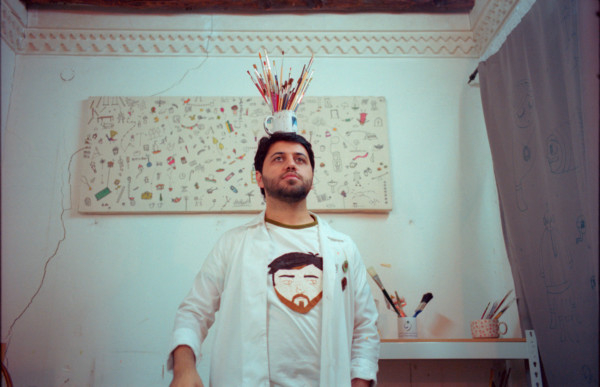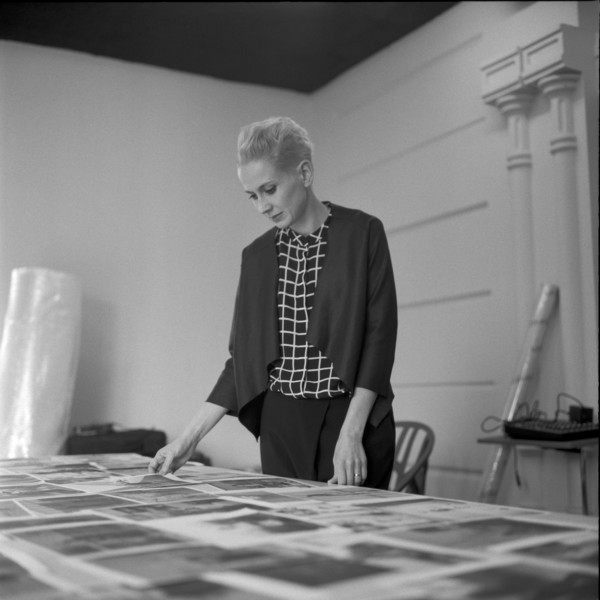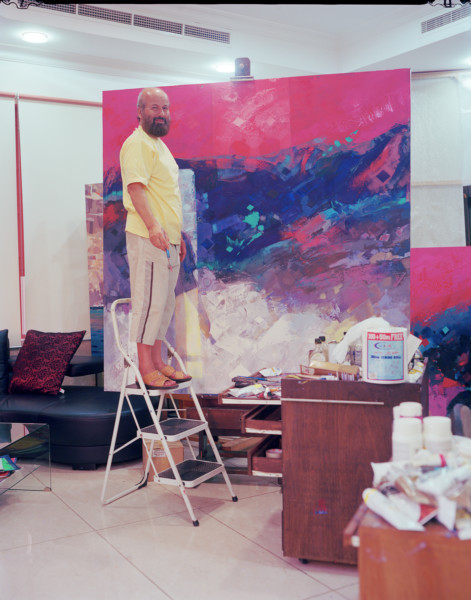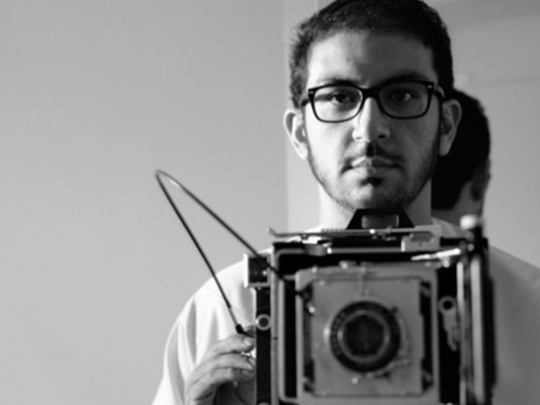
If you want to make friends with the artists, gallerists, curators and writers that make up the UAE’s art world and also gain an insight into their work, it would normally take years of trudging various studios, galleries and exhibition venues.
If you want to undertake this journey in one evening, you can head to the Al Maraya Centre in Al Qasba, Sharjah, and take in the “Art Index 1.0” by the young emerging Emirati photographer Ammar Al Attar — his first solo show, curated by Dr Alexandra MacGilp.
In the run-up to the show, Al Attar travelled around the country to take analogue photo portraits of artists, designers, curators, galleries, collectors and writers in their studios and their places of work. Exhibited are 50 black and white and colour pictures of leading artists, critics, curators and collectors.
These images provide a surreptitious way of looking at the behind the scenes activity of the thriving arts scene in the country. All his subjects are in the intimate surrounding of their studios, work spaces and amid their work or at work.
In an instant you are able to see the connections, whether it is Abdul Monem Al Serkal surveying the extension work at the Al Serkal Avenue in Al Quoz arts district, perched on a wheeled platform, or Abdullah Al Saadi surrounded by the bricks and stones that constitute the building blocks of his installation work, or Abdul Qader Al Rais with his typical abstracts, for which he is globally renowned.
It is indeed a quirky as well as fun journey, where Al Attar takes the viewer along too.
For example, you can join Mohammed Ibrahim on his Harley-Davidson and go up with him up the mountains in Khor Fakkan, join the moment when Hamdan Al Shamsi takes pen to paper for an apparent collage, catch Nasir Nasrallah balancing a cup full of paintbrushes on his head, a la Maradona, or experience the gentle welcoming smile of Shaikh Sultan Sooud Al Qassemi.
Giuseppe Moscatello, Director of Maraya Art Centre, says, “The UAE and the Gulf region have produced one of today’s most vibrant and youngest art ecosystems. Al Attar explores the phenomenon of this emerging local arts scene with a perceptive eye focusing on what happens behind the scenes. His research goes beyond a simple documentary project, as he engages with the community on a personal level and is invited into spaces that are usually private. Al Attar’s decision to use the medium of analogue photography in today’s world, where digital has replaced all the old technologies, is thought-provoking.”
According to MacGilp, “This project traces the shifting ecosystem of the local arts scene across geographies and generations. Al Attar’s analogue photographs, in both black-and-white and colour, offer insight into his work process as well as a behind-the-scenes look at the professional networks and friendships that exist amongst artists. He also exhibits his contact sheets and notebooks that share with the viewer his series of travels and conversations on the winding journey from one subject to another. In this age of digital and mobile phone photography and Instgram addiction, Al Attar is increasingly fascinated with older photographic technologies and the elements of time and chance that they allow.”
For MacGilp, working with Al Attar on this show was a pleasure. “I first encountered his work in 2013 at the AiR Dubai residency open studios when he presented his Sibeel Water project. The hardest part of the exhibition was selecting which works to include in the gallery as he has so many wonderful portraits in both black-and-white and colour to choose from. We have included some contact sheets as well as polaroids so you can have a peek behind the scenes and see how some of the other photographs turned out.”
“As he is working with analogue film, there is an element of chance in the development of the final photograph, which you don’t get with digital. This is an ongoing project, so he will continue to take portraits of artists, curators, writers and collectors in the UAE. He is creating an invaluable document of the UAE arts scene at an exciting time in its development.”
“Art Index 1.0”, coming as it does immediately after the Sharjah Biennale and the ongoing UAE pavilion at Venice Biennale, provides a delightful contrast that is playful as well as celebratory — a sign of confidence and a community that is proud of its achievements.
A fascination for analogue
Ammar Al Attar never set out to become a professional photographer. He earned a bachelor’s degree in Information Technology from Higher Colleges of Technology in 2003 and did his master’s in International Business from the University of Wollongong, Dubai, in 2008. He is working with RTA Dubai at present, having spent 10 years earlier with etisalat.
Ammar Al Attar bought his first camera out of curiosity, and the rest is history
Out of curiosity, he bought his first camera — a Canon 3.2MP — with his first salary. From then on it was a journey of exploration and learning. He attended workshops at the Emirates Photography Society based in Sharjah and started exploring outdoor and landscape photography. He also picked up tips from other professional and international photographers.
It was in 2007 that he chanced upon analogue photography and fell in love with it. Since 2010, he has stayed true to analogue. He has only one digital camera, which he uses for documenting his work or for video.
The present show was conceived three years ago and the actual shoot happened over the last two years, contacting the artists, making it to their studios, putting them at ease and catching them in their natural environment at work. “We have great artists, but I feel they don’t have much support. This year’s Venice Biennale focusing on 40 years of arts history in the region has given the country’s artists a great exposure. I felt it important to document the artists and their studios. The contemporary arts scene in the UAE offers a great variety and provides a great chance to document it. Within a couple of years there will be lot of changes. One of my aims is to continue with this project. That is why I have named the show ‘Art Index 1.0’.”
Al Attar believes there should be more interaction among artists, who “form a small community in a small country such as ours”.
“At present this happens only at various events. We should have more venues with affordable workspaces for artist-members and access to labs, production facilities etc as well as a critique programme where we can discuss art and each others’ work.”
Al Attar gathered fresh insights from some of the veteran artists he met. “Despite their reputation, they work in modest studios but at the same time, are steadfast about their vision and passionate about their work.”
Al Attar says he is attracted to analogue photography because it forces him to slow down, and makes him think about his work. “I like the tangible. I have more control and you can select from a vast range of cameras from the 1940s, use colour or black-and-white film. Besides, you can control the effects better.”
The feedback to “Art Index 1.0” has been good, he says. “Many liked the contrast and variety offered by the black-and-white and colour portraits. It also sparked a debate centred on UAE’s contemporary arts as well as the question whether this exhibition based on portrait photography can be considered as ‘art’.”
Al Attar is involved in a couple of other ongoing archival projects. “Reverse Moments” centres around the photography studios that came up in the UAE during the 1970s, with most of the studio owners and photographers hailing from India and Pakistan. The project seeks to “trace and collect the remaining objects, negatives and stories behind them.”
Another project he is part of is related to the standalone independent cinemas that dotted the UAE. The demolition of Golden Cinema in Bur Dubai brought together a community of photographers, videographers and bloggers to record the passing of an era that is intimately connected to our understanding of popular culture.
- N.P. Krishna Kumar is a freelance journalist based in Dubai.
“Art Index 1.0” by Ammar Al Attar is curated by Dr Alexandra MacGilp. It is on at the Maraya Art Centre, Al Qasba, until August 29, 2015.



